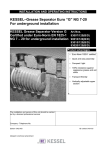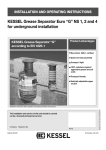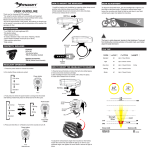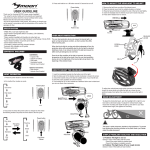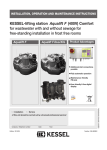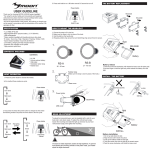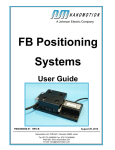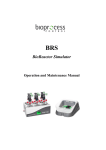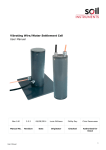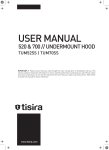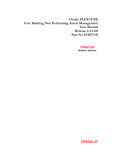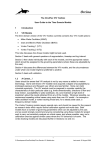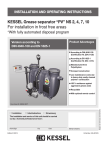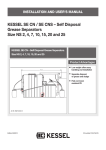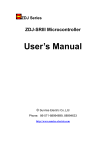Download NG 1, 2 and 4 For underground installation
Transcript
INSTALLATION AND OPERATING INSTRUCTIONS KESSEL Grease Separator Euro “G” NG 1, 2 and 4 For underground installation KESSEL Grease Separator “G” according to EN 1825-1 NG 1,2, 4 - for underground installation Product advantages Euro-Norm 1825-1 certified Quick and easy assembly Compact / light 100% resistance against aggressive grease and soil acids Transport friendly Vertically adjustable upper section The installation and service of this unit should be carried out by a licensed professional servicer Company - Telephone No. Edition 11/00-HG (Subject to technical amendment ID number 010-614 Table of Contents 1. Safety precautions Page 3 2. General 2.1 Application Page 4 2.2 Separator description Page 4 3. Installation 3.1 Installation Page 5 3.2 Watertightness test Page 5 3.3. Note Page 5 3.4 Installation illustration Page 6 3.5 Dimensioned drawing NG 1, 2 & 4 Page 6 4. Commissioning 4.1 Separator commissioning Page 7 4.2 Commissioning participants Page 7 5. Separator contents disposal Page 8 6. Maintenance Page 8 8. Replacement parts and accessories Page 9 9. Guarantee Page 10 10. Separator characteristics Page 11 11. Important contacts / info Page 12 2 1. Safety precautions Dear Customer, Before the KESSEL Euro Separator Version G is installed and placed in operation please carefully read and follow all of the instructions contained in this Installation, Maintenance and User’s Manual. Upon delivery of the Euro Separator please thoroughly inspect the separator to make sure that it has not been damaged during shipping. In case damage has occurred to the separator, please follow the instructions listed in the ‚Guarantee‘ section of this user’s manual. By installation, use, maintenance and repair of this unit please follow all appropriate DIN / VDE / DVGW safety precautions and accident prevention guidelines. Also please follow any local safety precautions and accident prevention guidelines established in your area. Please note that the unit is designed to receive kitchen waste water with a maximum temperature of 60 degrees Celsius (140 degrees F). Temperatures higher than 60 degrees Celsius could damage the unit. ________________________________________________________________________ Do not stand or place excessive weight on the separator. During disposal / emptying of a Type G separator, a step ladder should be used to help gain access to the openings on the top of the separator. NO SMOKING! Smoking must not be permitted near the separator during use, maintenance and repair of the unit due to the potential build up of methane / biogas. SLIPPERY WHEN WET! Take caution when standing / walking near the separator. During disposal, cleaning and maintenance the surrounding area can become extremely slippery due to spilled water / grease / fat. Separator Area Regulations: No access of the separator for unauthorized personnel No storage of food / groceries / provisions (for hygienic reasons) if the separator is installed underground within a building. The location of the separator should be chosen carefully as to allow sufficient access for maintenance, inspection, repair and disposal of the separator. The wastewater in a grease separator can contain bacteria. After coming in contact with wastewater or the separator itself, it is important to wash, clean and disinfect all skin which has been contaminated. All personnel having anything to do with the separator should have a sound knowledge of the above safety precautions. 3 2. General 2.1 Application According to DIN 4040 and EN 1825, the installation of grease separators is required wherever oils and fats from animals and plants are introduced into waster water systems. Uncollected, oils and fats can cause serious damage to wastewater piping and private / public waste water treatment plants. 2.2 Separator description The KESSEL Euro Grease Separator Version G consist of a grease separator with integrated sludge trap. The separator is constructed from Polyethylene (PE). Due to the smooth, wax like surface of the material Polyethylene, no additional protective coating is necessary. The separator is designed to be installed underground at a predetermined depth (below the frost level) and with the selected load class manhole cover (Class A, B or D). 4 3. Installation The KESSEL grease separator is delivered in ready for operation condition. If the separator consists of more than one container, each container will be packed separately on a pallet. Assembly material and accessories will also be packed on a pallet. In some circumstances the material and accessories will be inside one of the containers. When the shipment arrives, please inspect it immediately for damages which may have been caused during transport / shipping. The KESSEL Euro Grease Separator Version G should be installed underground as close as possible to the fixtures to which it is connected. In circumstances where it is not possible to install the separator in near proximity to the fixtures to which it is connected, the drainage piping (from fixtures to separator) should be equipped with heating elements. The inlet of the KESSEL Euro Grease Separator Version G must be installed below the frost level. This can be achieved by the use of the vertically adjustable upper sections. The manhole covers for the upper sections are lockable, odour tight and available in load classes A (1.5 ton), B (12.5 ton) and D (40.0 ton) and meet EN 124 standards. 3.1 Installation 1. The excavation in which the separator is to be installed must be level and capable of handling the appropriate loads. 2. Place the separator in the prepared excavation hole. Make sure the separator rests at the appropriate level. Fill the separator with water to the outlet level. 3. The excavation should now be backfilled with non-binding material such as sand, gravel or process. Backfill only the main body of the separator, do not backfill around the upper sections. The backfill should be firmly compacted at incremental levels (approx 500 mm). For load class D (40.0 ton) situations, the upper section and manhole cover of the underground separator must be poured into a steel reinforced concrete apron for proper load support. Additional information regarding this load class D support is available from KESSEL. 4. Connect the inlet and outlet of the separator to the drainage piping. 5. No vertical pipes should be connected within one meter of the inlet of the separator. This one meter section (immediately prior to the inlet of the separator) serves as a wastewater calming section which hinders turbulence which can introduce unwanted oxygen and foam into the separator. All connections of vertical pipe (outside of the 1 meter calming section) should me connected to the main inlet pipe with two 45 degree fittings rather than one abrupt 90 degree fitting. 6. Install and adjust the upper section(s) of the separator to the desired level and secure with the included clamp ring (clamp ring will rest on the chamber itself). Final upper section level adjustments can be made by manipulating the elevation adjustment screws located on the clamp ring 3.2 Watertightness test Before the separator is fully backfilled, the upper section and gasket must be tested for watertightness. To perform this test, insert inflatable closure balloons into the inlet and outlet of the separator and inflate to insure a tight seal. Fill the remainder of the separator with fresh water until the water level is toward the top of the upper section (where the manhole cover is placed). Check to make sure that there are no leaks. If there are no leaks, the inflatable closure balloons can be removed and the upper section can be backfilled and compacted. Note - When the outlet of the separator is to be installed below the sewer or wastewater piping level, a lifting station (based on DIN 1986 and prEN1825) must be installed. KESSEL offers a full line of lifting stations designed for this circumstance. Note - Underground separators to be installed below the groundwater table are available upon request. 3.3.Note The KESSEL Euro Grease Separator Version G is designed for locations where: 1) Dispersion of odours during the emptying, cleaning or maintenance of the separator will not pose a problem. 2) Access of the disposal hose from the disposal truck to the separator will not pose a problem. 5 3. Installation 3.4. Installation Illustrations (Class B, 12.5 ton) Illustration shows NG 2 Separator 3.5 Dimensioned drawing for NG 1, 2 and 4 sizes NG DN a 1 2 3 100 100 100 1470 1470 1470 b h 1100 1300 1100 1550 1100 1800 h1 h2 610 860 1110 540 790 1040 Waste water content Weight Sludge trap Separator Fat volume Storage 140 l 230 l 70 l 111 kg 200 l 370 l 120 l 120 kg 400 l 370 l 160 l 130 kg 6 4. Commissioning 4.1 Separator commissioning Before the separator is put into service please make sure that: The separator is completely clean, including inlet and outlet, and that the interior of the chamber is free of dirt and debris. The cleaned separator is completely filled with clean cold water up to the outlet. 4.2 Commissioning participants The commissioning of the separator is usually handled by a tradesman although this can be handled by a KESSEL contractor or KESSEL employee if desired. 1) The following people should be on hand during the commissioning: Building contractor representative Plumber / tradesman who will be maintaining the separator Building maintenance personnel Disposal company who will be handling the disposal account 2) Commissioning preparation Separator is completely filled with clean water 3) Commissioning Separator to be checked for watertightness and for proper functionality Contents of this user’s manuals to be discussed with those present 4) Transfer of this manual to the appropriate personnel 7 5. Separator contents disposal The first emptying (disposal) of the separator contents should take place within 2 to 3 weeks from the day the separator was placed into service. Disposal intervals According to DIN V 4040-2, it is advised that sludge and grease separators should be fully emptied, cleaned and refilled with cold fresh water at fourteen day intervals or at least on a monthly basis. In order for a grease separator to function as designed, it is very important that the separator is emptied at regular intervals as described above. Due to this, it is recommended that a licensed disposal company is contracted to empty the separator at regular intervals and during times when strong odours will not present a problem. Disposal procedure • Remove manhole cover. • Place disposal truck’s suction hose inside separator and remove entire contects of chamber. • Rinse and clean interior walls of chamber. Remove coalgulated fat/oil and debris. • Refill chamber with cold clean water. • Clean and grease all accessible seals. Replace seals if necessary. • Replace cover(s) and secure with cover clamps. 6. Maintenance Before the separator is placed into service and at regular intervals thereafter, it is important that: 1. The interior and exterior walls of the separator are thoroughly cleaned and checked for damage. Inlet and outlet equipment should also be checked. 2. All inspection and maintenance work should be logged into this user’s manual. Information concerning each disposal should also be kept on record. Please take care that: • This Installation, Service and Maintenance Guide is kept in a safe location where it is always available. • The disposal of the separator is only carried out by a certified company. • Safety precautions listed in this manual and all other relevant safety precautions are followed at all times. • Smoking IS NOT ALLOWED in the near proximity to the separator due to the potential build up of methane / biogas. 8 7. Replacement parts and accessories 9 8. Guarantee 1. In the case that a KESSEL product is defective, KESSEL has the option of repairing or replacing the product. If the product remains defective after the second attempt to repair or replace the product or it is economically unfeasible to repair or replace the product, the customer the has the right to cancel the order / contract or reduce payment accordingly. KESSEL must be notified immediately in writing of defects in a product. In the case that the defect is not visible or difficult to detect, KESSEL must be notified immediately in writing of the defect as soon as it is discovered. If the product is repaired or replaced, the newly repaired or replaced product shall receive a new warranty identical to that which the original (defective) product was granted. The term defective product refers only to the product or part needing repair or replacement and not necessarily to the entire product or unit. KESSEL products are warranted for a period of 24 months. This warranty period begins on the day the product is shipped from KESSEL to its customer. The warranty only applies to newly manufactured products. Additional information can be found in section 377 and 378 of the HGB. 2. Wear and tear on a product will not be considered a defect. Problems with products resulting from improper installation, handling or maintenance will also not be considered a defect. 01.01.2002 10 9. Separator characteristics Type Production number / production year Weight / kg length x width X height EN Approval Sludge trap volume / l Oil storage volume / l Control stamp Material (Accessories) This unit has been checked for watertightness to be sure that it is fully operational before leaving the factory. Date Name of examiner 11 Important contacts / Info Separator Type Day / Hour Project description / Building services supervisor Address Telephone / Fax Builder Address Telephone / Fax Planner Address Telephone / Fax Contracted plumbing company Address Telephone / Fax Commissioning no. KESSEL System operator / owner Address Telephone / Fax Other remarks The system operator, and those responsible, were present during the commissioning of this system. ______________________________ Place and Date 12 Everything for drainage Backwater valves and cleanouts Polymer and cast iron drains Volatile liquid traps Lifting stations, pumps, warning and control units Rainwater management systems Grease separators Oil/fuel and coalescence separators Inspection chambers Custom projects for industrial applications 13













